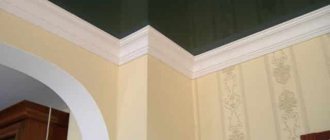What to do if there is a flood and water has accumulated in the stretch ceiling? Of course, we need to drain it from there - and preferably with minimal losses. How to do this yourself in order to save furniture, decoration, appliances and not aggravate the situation - we will look at this in this article.
Initially, you need to understand that a PVC ceiling is not just a beautiful decorative element, but a multifunctional element of the interior. If the neighbor above flooded the apartment, the film will hold all the water and make it possible to pump it out of the sagging ceiling.
If water has collected inside the fabric ceiling, it must be pumped out as soon as possible. The fabric is not designed for such loads and will not be able to retain moisture for a long time. But even such a canvas will give you time to remove the most valuable things from the room.
How much water can the ceiling hold?
Hypothetically, a stretch ceiling can withstand a load of up to 100 kg/m2. This means that the canvas in a 10 m2 room can withstand a ton of water. But you shouldn’t be rigidly attached to this figure.
How much water a suspended ceiling can withstand will depend on a number of additional factors:
- quality PVC film;
- installation level . Have all the installation rules been followed, have the installers saved on the number of screws, stiffeners, etc.;
- the presence of seams on the film (a soldered ceiling may not withstand a large volume of water and burst at the junction);
- ceiling area - the larger it is, the less load per square meter the film can withstand (the laws of physics have not been canceled);
- forms . Round - will withstand more weight than rectangular, and narrow and long - will protect better than square;
- tension level . According to the instructions, the area of the film should be 5–7% smaller than the size of the room (so that it does not sag, but is tightly stretched). But some manufacturers, in an attempt to save money, make the canvas 9-10% smaller. Such savings make themselves felt just in moments of critical situations. Excessive tension, combined with the weight of the water, leads to the film bursting or flying out of the fastenings.
When determining how many liters a particular ceiling can hold, it is better to proceed from the worst case scenario (both the installers and the manufacturer saved money, but the film turned out to be a fake) - in this case, the ceiling will withstand a load of 60-70 kg/m2.
If all the circumstances are most favorable (quality, size, shape), then the permissible load can be safely doubled.
Fabric ceilings have much worse performance:
- the fabrics used for stretching are not airtight. They are treated with special compounds that increase water resistance, but they do not provide 100% protection;
- Unlike film ceilings, fabric ceilings are not elastic. The weight of a large volume of water will simply tear the fabric out of its fastenings.
It is worth noting that fabric ceilings are ordered much less often than film ceilings and are installed in most cases in bedrooms and living rooms. While floods occur more often in kitchens and bathrooms.
How much water can a suspended ceiling withstand and how many days can it last?
The manufacturer provides information that the tension structure will protect the apartment from flooding if the amount of water per 1 m² of panel is no more than 100 liters.
When troubleshooting the problem, you need to consider the following factors:
- the large size of the ceiling reduces the permissible load on the canvas;
- too much film tension reduces its strength;
- the properties of matter affect its ability to hold water.
On average, the amount of liquid retained by the canvas is 70-120 liters per 1 m². The coating retains water for a long time when its volume does not increase. The apartment owner should not delay solving the problem.
Due to increased humidity, mold forms in a confined space above the ceiling. A tightly stretched coating will burst when colliding with sharp objects. The risk of tearing increases when water accumulates at the joint of the coating. Draining should be done within 2-3 days after the problem appears.
Which materials withstand flooding better?
Of course, PVC film will withstand flooding better than fabric. If you manage to drain the water without damaging the stretch ceiling fabric, then after drying and reinstallation there will be no trace left of the flood. PVC film will return to its original appearance without losing color, shape or presentation.
The fabric fabric will not be able to withstand such a test. It will definitely have to be changed. If there was a lot of water, the fabric will tear out of the profile; the fabric cannot be reinstalled. A small flood will also completely ruin the fabric. After drying, a stain will remain on it, and the fabric itself may sag in the area of flooding.
What to do after draining the water
After all the water has been drained, it is necessary to give the stretch ceiling its original appearance. The algorithm of actions depends on the scale of the accident and the material used to make the fabric.
PVC
If there is a slight leak, the lamp or the removed edge can be immediately put back. To achieve straightening of the stretched section of the film, it is heated with a gas gun or a hair dryer. You need to act carefully, ensuring uniformity of blowing hot air. After large-scale pouring, in addition to water, a lot of dirt accumulates on the film - damp putty, plaster, etc. This debris can be removed by dismantling the canvas (at least on one side).
To straighten a stretched section of a stretch ceiling, you need to heat it with a gas gun or a hair dryer.
When removing PVC film, special care must be taken, acting slowly and without being too harsh. To wipe the removed fabric, a soft cloth or microfiber is usually used. Next, hang it indoors and wait for it to dry (sometimes this takes up to a week).
To insert the film back, you need to align the bent profile by tightening the screws. A spatula is used as a tool for threading the canvas (it is better to wrap it in a paper napkin). To eliminate sagging, the heating method described above is used.
Refilling the stretch ceiling fabric
Textile
Fabric canvas causes less hassle. If it is not torn or dirty during flooding, it is simply removed from the clips, dried and inserted back. There is no sagging on products of this type, because they don't stretch. This eliminates the need to heat the surface.
How to understand that there is water there?
With fabric everything is simple - it will darken very quickly and begin to drip from it. With a large volume of water, the canvas will partially sag and then break out of the fastenings.
Nothing will leak from PVC film. The only possible leak is in the places where the curtain rods and lighting fixtures are attached, but this is rare. Due to the rigid fastening of the mounting rings to the floor slabs, the holes usually remain above the main sheet filled with water.
If there is a large volume of water, it will all gather in one place, and the film will sag like a bubble. The lower edge of the bubble can be 50–70 cm below the main ceiling level. Do not be afraid of this - after removing the moisture and drying, the canvas will return to its original appearance.
What types of suspended ceilings retain water better?
Let’s say right away that PVC films and fabrics are capable of retaining liquids, the only difference is in the time it takes to maintain integrity. Due to the peculiarities of the weave of fabric threads, water seeps through the coating, so it is important to have time to drain the liquid within 1-2 days. Then the fabric will begin to let in the full amount of moisture and the apartment will become unusable.
High-quality PVC films protect against flooding for any length of time until the owner fixes the leak himself. The material can withstand up to 100-150 l/m2, so you don’t have to worry about the film breaking.
Important! If for some reason it is necessary to install a fabric sheet in an area at risk of flooding, finely porous Cerutti is selected. The fabrics are varnished on both sides and impregnated with a water-repellent composition. The properties of the material should be clarified immediately, before work begins.
Three ways to drain water
The only sure way is to call the manufacturer’s installers and entrust this work to them. Moreover, after removing the moisture yourself, you will still have to call them. Even if you managed to remove everything to the last drop on your own.
PVC film is airtight - therefore, the floor slabs will remain wet. Moisture will cause mold to appear, which can go down the walls and go beyond the stretch ceiling.
To avoid such a scenario, the canvas must be partially or completely dismantled after flooding. Dry everything thoroughly and reinstall.
Therefore, the remaining two methods can only be called a temporary solution to the problem.
Preliminary preparation
Before you start fixing the problem, you need to take care of your own safety. At the first signs of flooding, the room should be completely de-energized to avoid a short circuit or electric shock.
Then you should take care of the safety of household items. Take everything you can out of the room (primarily electrical appliances). It is better to cover the remaining items, furniture and floors with polyethylene.
After completing the initial tasks, it is worth identifying and eliminating the cause of the flooding . There are three options here:
- The upstairs neighbors flooded.
- Water supply pipes between floors burst.
- Failure of the heating system in the floor slab.
In the third case, there is no need to fix the problem yourself. Chemicals added to the heating system can have negative health effects during the leak repair process.
In the first two cases, you can cope on your own, having previously eliminated the cause of the flood (by contacting the housing office and closing the riser).
You need to prepare for the process of eliminating a flood so as not to make it worse than it was (tear the film or flood the entire room). There is no need to panic or rush. Water under the ceiling can remain for several hours without consequences, and in some cases for several days.
The most convenient way to fix the problem is with three people:
- the first one regulates and directs the jet;
- the second - continuously holds water containers;
- the third one pours the contents of the buckets into the sewer.
In extreme cases, two people can handle it, but in this case you will have to stock up on a large number of containers - after all, a suspended ceiling can contain hundreds of liters of liquid.
It will not be possible to eliminate a flood alone without proper preparation (either water will end up on the floor or the canvas will be damaged). If you couldn’t find helpers, it’s better not to waste your energy and nerves, but to wait for specialists.
If you managed to form a liquidation team, then in addition to buckets, it is advisable to acquire a stepladder and a hose - this will make the process much faster and more productive.
Removing water through technical openings (openings for lamps and cornices)
After completing the preparatory stage, you can begin draining. Getting water out of a stretch ceiling is quite simple. The main thing is to take your time so as not to damage the canvas.
Stages of work
- Carefully remove the lighting fixture closest to the leak (after first making sure that it is de-energized).
- If there is a rubber hose:
- insert it into the resulting hole so that one end of the hose reaches the empty container, and the other is immersed in water where it sags;
- create a vacuum in the hose (pump it out using a pump, or draw in some air from the hose, like from a cocktail straw), so that water begins to flow down it into the container;
- if the water masses are far from the end of the hose, they can be adjusted to the hole. If your height allows, use your hands; otherwise, use a soft mop. This should be done with smooth, wide movements without pressing hard on the canvas.
- If there is no hose:
- Place a container under the drainage hole. Spare buckets should be kept nearby so that filled ones can be quickly replaced with empty ones;
- carefully pull down the edges of the hole so that it is slightly below the main plane of the ceiling;
- Using a wide soft mop, gradually move the water to the pumping site.
- After the bubble at the flooding site disappears, we can assume that the bulk of the water has been drained, and the ceiling and repairs have been saved.
After this, you can safely wait for the repair team to dismantle, dry and reinstall the tension fabric.
Over the edge of the structure
If it is not possible to remove the chandelier, or the lamps and cornices are installed on the walls or in a plasterboard box rather than canvas, then the process of self-removal of water follows a different scenario.
Work progress
Initially, you need to find out by what method the canvas was secured. This information may be specified in the supply agreement, or you can check with your seller. If this information is not in the contract, as well as communication with the manufacturer, you can try to visually determine the installation method.
There are three main methods of attaching PVC film (for fabric canvas, the installation method is not important; the fabric cannot be reinstalled, so the ceiling will have to be changed in any case):
- Harpoon. The most common method of installing PVC ceilings. 90% of all products are installed using this method. To dismantle the edge of the ceiling, just remove the masking tape (to do this, simply pull it with your hand) and press the harpoon vertically upward, it will unfasten and come out of the groove. You need to press very carefully so as not to damage the canvas. A mild spatula with rounded edges is suitable for this purpose. If you don’t have a suitable tool at hand, you can use a plastic card or something similar in shape and properties.
- Wedge. With this installation method, dismantling the edge will be a little more difficult. You will have to pull out the masking insert, then carefully move the wedge to release part of the canvas.
- Clip-on. Dismantling the canvas with this installation is quite simple. Simply press gently on the edge of the film where it contacts the upper half of the clip. The clamp will loosen and the film can be pulled out of the latch. The main thing is to do everything smoothly and carefully, without sudden jerking movements.
Once the correct dismantling method has been established, the water can be removed. To do this, you will have to remove 50–100 cm of the canvas from the profile. If the dismantled part of the film is smaller, then there is a high probability that water from the suspended ceiling will flow onto the wall, ruining the wallpaper. Then after the flood you will have to carry out the repair again. If you clear a gap of more than a meter in length, then the combined weight of the film and water can tear out a much larger piece of canvas from the profile than planned. That is, spontaneous dismantling of the entire ceiling will occur.
Then you can proceed in exactly the same way as when working with a technological hole. Pump out the moisture by inserting the hose inside, or carefully release the water through the unfastened edge. The option with a hose is preferable, as there is less chance of flooding the wallpaper.
Tips and tricks
When draining water from a suspended ceiling yourself, it is important to follow several recommendations:
- When preparing tools for draining, it is advisable to purchase hose plugs. Constantly squeezing its edge will be inconvenient, and a small amount of water may leak.
- Most often, the water bubble on the ceiling appears smaller than the actual volume of water. Therefore, it is impossible to assess the scale of the flood by eye. You need to prepare as many containers as possible to collect water.
- If your neighbors flooded the ceiling with hot water, then you need to start draining it as soon as possible. Increased water temperature with prolonged exposure to the canvas deforms it so much that subsequently restoration of the coating will be impossible.
- The maximum number of days for which water drainage can be delayed is 3 days. It is advisable to start fixing the problem immediately, but if the apartment owner does not dare to drain the water himself, and the flood happened over the weekend, then you can wait. During these days, it is recommended to turn off the power in the flooded room.
- An urgent solution to the problem requires a ceiling that is sagging in the place where the chandelier is attached with sharp corners or decorative elements. With strong tension, the coating becomes thin and less durable. If the bubble comes into contact with a sharp corner, it may burst. Ceilings with seams are also dangerous.
- If the canvas is damaged, the small hole can be temporarily closed with a sticker or masking tape. The ceiling needs to be replaced to avoid damage to property in the event of another flood.
- To pump water out of a hose, inhaling air from the tube with your mouth is only possible in extreme cases. For this purpose it is better to use a medical bulb. If you inhale sharply, dirty water can enter the mouth or lungs.
- When installing ceilings in places where plumbing runs in the upper apartment, it is better to install film ceilings. They retain water better and recover more easily.
- Do not smooth out a small water bubble. In this case, the water spreads over the entire area of the covering and can flow in the places where the canvas is attached to the walls. To avoid this problem, when installing the ceiling you need to use a special sealant that will reliably close the gaps between the profile and the wall.
- To prevent a flood in your own apartment during the renovation stage, you need to lay the floor correctly. Professionals recommend laying bitumen and roofing felt screeds. This is a reliable way to retain water within your apartment and protect your neighbors’ ceilings from a similar problem.
- It is very difficult to carry out flood elimination work on your own alone. The help of 1-2 people is required, otherwise everything can end in disaster.
- If the scale of the flood was very large, or the water stood inside the stretch ceiling for more than 3 days, complete dismantling of the canvas and drying of the main ceiling will be required. The plaster must be treated with special agents to prevent the formation of mold.
- For drying you need to use only a heat gun or a hair dryer. In unreliable sources you can find advice on restoring the coating using a regular hair dryer. This method doesn't work. To restore the canvas you need at least 200 °C.
Common mistakes when draining yourself
Hearing the sound of dripping water overhead (in a stretch ceiling, the impact of drops on the film membrane is quite loud and resembles a ringing drumbeat), most people begin to panic.
There's no need to rush. Having closed the riser and turned off the electricity, you need to sit down and think about how best to remove the water that has gotten inside.
A flooded ceiling can hold water for several days without consequences (even if a hundred liters have accumulated inside). Therefore, there is no need to panic and pierce a bubble of water in an attempt to urgently get rid of the flood.
By the way, making a hole in the film is a very bad idea. Even a tiny hole, under the influence of the gravity of the water, will spread out in a few seconds and turn into a huge meter-long hole through which a stream of water will rush like a waterfall onto the floor. As a result, the ceiling will be hopelessly damaged, and the furniture and repairs will be significantly damaged by the flood.
A natural question arises: why doesn’t the hole in the chandelier spread when water is drained through it? It's simple. During installation, special mounting rings made of thick plastic are glued around the perimeter of all technological holes, which keep the film from spreading.
The next common mistake concerns ceiling repairs after flooding. There is an opinion that by draining the water after a leak and waiting a couple of days (to dry), you can consider the issue closed and return to the usual rhythm of life. But it’s worth thinking about: will the concrete ceiling dry under the film? It is more likely that the moisture will remain there for a long time, it will be supplemented by mold, and the microclimate in the room will significantly worsen.
Some sources advise doing the drying yourself using an industrial or powerful household hair dryer - it’s not worth it. If this trick can still work with a fabric ceiling (but it will take a very long time to dry), in the case of PVC film these actions are absolutely useless.
Due to the tightness of the film, the maximum that can be achieved is to create steam in the gap between the floor slabs and the canvas. It will end up getting even worse. If previously one corner of the room was wet, then after the “steam bath” all the floor slabs in the room will become wet.
You should not count on the fact that excess moisture will escape along with steam through the soffit openings. To achieve this effect, you will have to continuously blow hot air onto the film for several days. During this period, the film will be damaged faster than the floor slabs will dry out.
Draining water if lights are missing or far away
The simplest versions of suspended ceilings are not equipped with lamps, so there is no ready-made hole for drainage. It also sometimes happens that the pear forms far from the lighting fixture (driving it halfway across the room is dangerous). In this case, the water is drained through the corner section closest to the bubble.
The algorithm of actions is as follows:
- The edge of the film is carefully removed from the mounting profile. It is better to choose an area for this that is away from pipes and other communications. To do this, use a plastic spatula or other similar device. Metal tools with sharp edges are not suitable in this case, because... they can cause serious damage to PVC fabric. Sometimes an additional decorative insert is placed under the profile, so it is necessary to remove the canvas with special care. To simplify dismantling the film, it is recommended to warm it up a little with a hairdryer.
Removing the edge of the tension fabric to drain the water - Water is carefully drained through the removed edge into a substitute container.
Draining water over the edge of a suspended ceiling- Alternative way. A flexible hose is inserted inside the resulting gap (recommended length - 40-50 cm): in such a situation, it will not be possible to drain the water directly. The second end of the hose is placed in an empty bucket.
- It is recommended to hold the pear a little while draining the liquid, otherwise its contents will spread over the surface. This is fraught with leakage along one of the walls.
- To speed up the procedure, it is recommended to pull the edges of the film down a little: it is best if the drain point is at the same level as the requested area. When pulling, you should avoid sudden movements.
Draining water from a suspended ceiling without using a technical hole
You can see more details about this method of draining water from a tension fabric in the video:
Repair and elimination of the consequences of the flood
To avoid such a development of events, the film must be removed, at least partially, and everything must be dried thoroughly after flooding. You can do this in two ways:
- Temporarily leave the ceiling dismantled to dry naturally. This method is less expensive financially (you can dismantle the film yourself, paying only for re-installation), but inconvenient in terms of implementation. Depending on the time of year and the degree of flooding, drying can take from a couple of days to a couple of weeks. It will be very problematic to use the room all this time. A fabric that is unstable to mechanical damage will be laid out in it. If the family has small children or pets, most likely the PVC film will not survive such drying.
- Pay for a full range of services: dismantling, drying and re-installation. Money for these events can be demanded from the neighbors who caused the flood. This approach will reduce time costs to 1–2 days. In this case, responsibility for the performance of the work and the integrity of the canvas will lie with the company carrying out the work.
If there are doubts about the quality of drying, it is advisable to treat the floor slabs with antifungal compounds before reinstalling the stretch ceiling. This will prevent possible mold formation.
When reinstalled under the action of heat guns, the canvas will straighten out and take on its original appearance. But part of the canvas may be dirty (fingerprints, mop marks, etc.).
Cleaning after a flood is no different from regular ceiling cleaning. Using mild, non-abrasive products, all visible dirt can be easily removed from the film. Typically, manufacturers of household chemicals indicate on the label whether this product can be used on suspended ceilings.
How much do services for draining water from suspended ceilings cost?
If you entrust the job to a master, the work will not take much time. The price of repairing suspended ceilings after flooding is determined by the type of liquid removal, the method of drying and bringing the coating to its original form. On average, the service takes up to 3 hours, but only if the integrity of the base base is not damaged, there are no fallen pieces of plaster or other debris.
Production, materials and machines for the production of suspended ceilings
On a note! If the plaster has collapsed and the craftsmen offer services to restore the appearance of the coating, it is better to agree. Materials may leave streaks on the surface of the film or fabric, so the canvas should be dismantled, cleaned and reinstalled.
The cost of the service starts from $35-40 (2600-3000 rubles), while the owner receives guarantees that the work will be performed efficiently.
Can flooding be prevented?
The only way to prevent a flood is to eliminate all possible causes:
- change heating and water supply risers;
- negotiate with the upstairs neighbor to waterproof the floor.
But there are a number of nuances:
- new pipes may be defective, or the specialists involved in their installation may not be qualified enough;
- a neighbor may refuse to waterproof the floor. After all, this process will cause him a lot of inconvenience: high-quality waterproofing is a very expensive phenomenon, but why does a neighbor need extra expenses;
- it can only be carried out during a major overhaul, completely replacing the flooring, doors, etc.;
- if a flood is caused by someone living even higher up, then all the water will remain in the apartment of the neighbor above, and will not flow down, which is also not very good for him.
Therefore, it will be quite difficult to persuade a neighbor to carry out such work.
Theoretically, it is possible to waterproof the ceiling, but almost no one does this for two reasons:
- The height of the ceilings is reduced, and taking into account the additional loss of centimeters when installing the tension fabric, the total amount can be quite significant.
- The financial costs of high-quality waterproofing are higher than the costs of replacing a PVC ceiling, which makes this process unprofitable.
Due to the listed nuances, it is almost impossible to achieve one hundred percent protection from a flood, and even if possible, it is not practical in material terms.
How to restore a suspended ceiling after flooding
After eliminating the bay, the PVC film is heated with a construction or even an ordinary hairdryer, bringing the nozzle to the material at a distance of 30-40 cm, no closer - you can burn through the coating. Even better is to use a heat gun. Under the influence of high temperature, the ceiling can be leveled in 3-4 minutes. If the film has been dismantled, when warming up, simultaneously tuck the edges of the film into the profile. The remaining folds here and there are also smoothed out by heating.
If the stretch ceiling was not flooded too much - a little water had accumulated and the bubble was small, then the canvas will straighten out on its own. You don’t have to call a technician or take risks with heating, but just wait 3-4 days.
How much does it cost to call specialists?
The cost of repair work depends on a number of factors:
- pricing policy in the region (in large cities and small towns the amount may differ significantly);
- area and complexity of the ceiling;
- installation method;
- a set of necessary services (installation, dismantling, drying).
The master will be able to name the exact amount only after visiting the site, but you need to focus on 30–50% of the original contract amount.
Don’t be afraid of such large numbers, because in the absence of a stretch ceiling, the cost of repairing and replacing furniture and equipment would be much higher.
How can water end up on the ceiling?
In addition to sloppy neighbors, there may be several reasons for this phenomenon:
- Penetration of cold water due to a break in the main pipeline.
- Hot water from water supply and heating systems.
- Liquids from the sewer.
- Rain flows entering the room from storm drains or through the attic.
Also, moisture without objective reasons can appear as a result of “dry” leaks in hot weather, when condensation accumulates under the coating.
Important! If cold water gets on the ceiling, it will cause minimal damage to the coating. If hot liquid accumulates, you will most likely have to completely replace the blade. The same applies to sewage drains. In this case, the suspended ceiling will not only be significantly deformed, but will also lose its aesthetic qualities.
How is liquid retained on a suspended ceiling?
Water flowing from the water supply flows down the ceiling beams, floor slabs and walls, gradually seeping into the ceiling space between the base base and the decorative canvas. If the structure is mounted securely, liquid will gradually collect on the canvas, stretching it.
The strength of PVC film sheets allows the coating to withstand water loads, avoiding breakthroughs. The main thing, even when choosing materials for installing a tensile structure, is to consider products only from trusted manufacturers. Then you will be able to save the furniture and return the surface of the stretch ceiling to its original appearance.
What not to do if the suspended ceiling is flooded
If it was decided to eliminate the flooding yourself, then it is recommended to take into account all the recommendations during the work process and follow a certain algorithm, otherwise there is a high probability that the film will be damaged.
There are several basic mistakes that almost everyone makes:
- incorrectly estimate the volume of water;
- many try to pierce the water bubble;
- To solve the problem, use available means.
The required number of empty containers must be prepared in advance, since it will not be possible to look for them in the future.
Important! If the suspended ceiling leaks, this indicates poor quality installation work. Water can only seep through the fabric, not through the film.
Draining liquid over the edge of the tension fabric
On some canvases there is no mounting ring for the lamp. Then the water drains through the edge located closest to the bubble of liquid. It is better to carry out the procedure together with a partner.
First you need to carefully free the required area from the frame. The canvas must be supported to prevent water from overflowing. Do not press on the bubble, otherwise the liquid will “spread” over the entire ceiling surface. In the future, this will lead to the appearance of mold. All manipulations must be carried out very carefully so as not to deform the canvas. A hose is also used for draining. It is inserted into the hole, and then the water is drained into a container over the edge of the structure.
What happens if a suspended ceiling made of PVC film is poured?
A distinctive feature of PVC sheets from fabric is that they are able to withstand large volumes of liquid for quite a long time - from 100 liters, while water will not leak into the room. In addition, you can fix the problem yourself and as quickly as possible. The only drawback is that in order for the ceiling to take its previous shape, it must be heated with a heat gun. For these purposes, you can contact an installation company that services PVC sheets or rent a heat gun.
Important! If water remains in a suspended ceiling for a long time, this can lead to the appearance of fungus.
How to dry and restore a suspended structure
After eliminating the flood, 2 problems arise: how to dry the canvas and return it to its original shape. Experts emphasize: after draining the liquid, you need to wait for the internal surfaces to dry completely. It is necessary that air enters the cavity at this time, so lighting fixtures cannot be installed during the week. To prevent mold from appearing, it is advisable to treat the entire problem area with an antiseptic - in the form of an aerosol it will be easier to apply it to areas with difficult access.
The area in which there was a bubble becomes flabby and becomes covered with folds. Installers use a heat gun to level it: the device heats the film, and as it hardens, it straightens and stretches.
The gun can be replaced with a household or construction hairdryer: you need to direct a stream of hot air onto the film, slowly moving the nozzle, and treat the entire area. To avoid melting of the material, you need to monitor the distance to the surface and do not hold the hair dryer in one place. This independent measure can be very effective if you ensure that the integrity of the canvas is maintained during draining and pay attention to every fold.
You can dry the suspended ceiling using a regular hair dryer.
The success of manually eliminating water accumulation directly depends on the sequence of actions and the accuracy of the intervention. If you strictly follow the described stages of work and avoid the use of sharp objects, you can return the suspended ceiling to its original state without loss.
First actions in case of flooding
The first thing that owners whose apartment is flooded should do is turn off the power. To do this, unscrew the plugs and turn off the machine in the electrical panel.
Then you need to find neighbors to inform the culprits about the leak and eliminate the source if the cause of the flood is their carelessness. Or shut off the common riser if the owners of the upper apartment have nothing to do with it.
Next, clear the room of furniture that can be removed. Protect other interior items with plastic wrap. Prepare buckets and basins for draining water. The more containers you find, the better. After this, proceed to removing water from the stretch ceiling.











